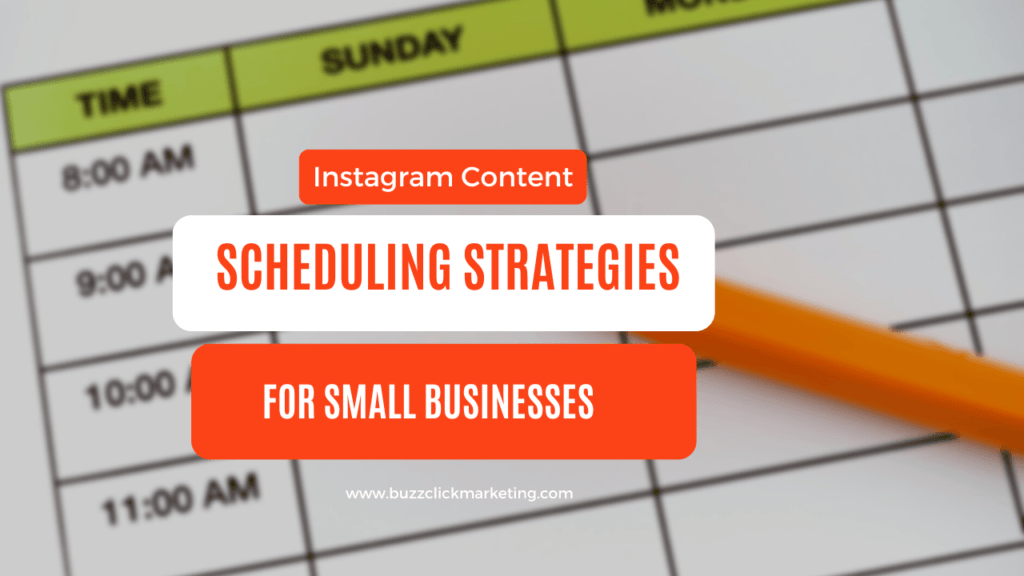In the dynamic world of social media, Instagram stands out as a powerful platform for small businesses aiming to enhance their visibility and engage with their target audience. However, with millions of posts shared daily, making your content stand out requires strategic planning and smart scheduling. This guide delves into effective content scheduling strategies tailored for small business Instagram accounts, ensuring your brand not only captures but also retains the attention of your audience.

Understanding the Importance of Content Scheduling
Content scheduling goes beyond mere consistency; it’s about ensuring your posts reach your audience when they’re most active and engaged. This strategic timing increases the visibility of your content, driving higher engagement rates and fostering a stronger connection with your followers. It also streamlines your social media management process, allowing you to allocate time efficiently and focus on creating quality content.
1. Understanding Your Audience
Target Small Business Owners and Marketers:
Before diving into content creation and scheduling, it’s imperative to deeply understand your audience—small business owners and marketers. These individuals are often juggling multiple roles and looking for efficient, actionable insights to improve their social media presence. Tailor your tone and language to address their specific needs and challenges. Focus on providing value through practical tips, industry insights, and success stories that resonate with their experiences and aspirations.
Analyzing Audience Behavior:
Use Instagram Insights or third-party analytics tools to gather data on your followers’ demographics, interests, and online activity patterns. This information helps in crafting content that speaks directly to your audience’s preferences and pain points, ensuring higher engagement and relevance.
Segmenting Your Audience:
Consider creating content that caters to different segments within your audience. For example, some posts could target beginners in social media marketing, while others could cater to more experienced marketers looking for advanced strategies. This approach ensures your content appeals to a broader range of followers, maximizing engagement across your account.
2. Segment Your Audience by Industry
To further refine your content strategy, segment your audience based on their industry. Different sectors, such as retail, restaurants, and B2B, have unique challenges, peak activity times, and content preferences. Offering specific strategies for these distinct types of businesses can make your advice more relevant and actionable.
- Retail Businesses: Focus on showcasing products through high-quality images, leveraging user-generated content, and announcing sales or promotions.
- Restaurants: Share behind-the-scenes looks in the kitchen, highlight menu items, and encourage customers to share their dining experiences.
- B2B Services: Provide valuable industry insights, share success stories or case studies, and focus on networking through thought leadership content.
By tailoring your content to the specific needs and interests of these industries, you can increase engagement and foster a deeper connection with your audience.
Focus on Pain Points
Running a small business Instagram account comes with its own set of challenges. Addressing common pain points can help your audience overcome these hurdles effectively.
Time Constraints
Many small business owners struggle with finding the time to consistently post on Instagram. Automating the scheduling process using tools like Later, Hootsuite, or Buffer can save precious hours. These platforms allow for bulk uploading and scheduling of posts, freeing up time that can be spent on other business activities.
Content Creation
Creating fresh, engaging content regularly can be daunting. Encourage businesses to repurpose content across different formats (e.g., turning a blog post into a series of Instagram posts or stories) and tap into user-generated content to diversify their feed without the constant need for new content creation.
Engagement
Boosting engagement on Instagram is a common challenge. To increase interaction, schedule content that prompts a response, such as asking questions, running polls in stories, or creating interactive content like quizzes. Engage with your followers by responding to comments and direct messages to foster a community around your brand.
2. Content Scheduling Strategies
Effectively managing your Instagram content requires a blend of planning, tools, and techniques. Here, we outline different scheduling methods, complete with step-by-step guides and time-saving tips.
Different Scheduling Methods
Native Instagram Scheduling:
Instagram’s native scheduling feature is available for business accounts through the Creator Studio. This allows you to schedule posts and IGTV videos directly within the platform.
- Step-by-Step Guide: Access Creator Studio, connect your Instagram account, and click on ‘Create Post’. Choose your content type, upload your media, craft your caption, and then schedule your post by selecting a date and time.
Social Media Management Tools:
Platforms like Later, Hootsuite, and Buffer offer more comprehensive scheduling options, including posts, stories, and analytics.
- Step-by-Step Guide: Sign up and connect your Instagram account to the platform. Upload your content, draft your captions, and drag and drop your posts onto the calendar. These tools often provide the best time to post suggestions based on your account’s historical engagement data.
Batch Creation Techniques:
Batching involves creating and scheduling content in bulk. This method is ideal for maintaining consistency and saving time.
- Step-by-Step Guide: Dedicate specific days for content creation, editing, and scheduling. Use a content calendar to plan your posts for the month. Create all your content, captions, and hashtags in advance, and then schedule them using your chosen tool.
Time-Saving Tips and Automation Techniques
- Content Templates: Use templates for posts and stories to maintain a consistent aesthetic while reducing design time.
- Hashtag Sets: Prepare sets of relevant hashtags for different types of posts. Most scheduling tools allow you to save and reuse these sets.
- Repurposing Content: Transform existing content into multiple formats. For example, a blog post can be turned into a series of Instagram posts, stories, and even a short video.
- Automate Engagement: Use tools to automate responses to common questions in direct messages or comments, ensuring you maintain engagement without constant monitoring.
3. Content Calendar & Planning
A well-structured content calendar is the cornerstone of a successful Instagram strategy. It facilitates consistency, and strategic planning, and ensures a balanced mix of content types and themes.
The Importance of a Content Calendar
Consistency and Strategic Planning:
A content calendar helps you maintain a consistent posting schedule, which is crucial for keeping your audience engaged and growing your following. It also allows you to plan your content strategically around key dates, holidays, product launches, and promotional campaigns, ensuring that your content is relevant and timely.
Suggesting Content Ideas:
Inspire your readers with a variety of post formats, themes, and content pillars to ensure their feed remains engaging and diverse. Here are some ideas:
- Post Formats: Mix up your content with images, videos, carousels, stories, and reels to cater to different audience preferences.
- Themes and Content Pillars: Identify themes or content pillars relevant to your brand and audience. For example, a restaurant might focus on themes like “Behind-the-Scenes,” “Menu Highlights,” and “Customer Favorites.”
- Content Ideas:
- Educational Content: Share tips, tutorials, or industry insights relevant to your audience.
- User-Generated Content: Encourage customers to share their experiences with your brand and feature their content on your profile.
- Interactive Content: Use polls, quizzes, and question stickers in stories to engage your audience directly.
4. Best Practices & Optimization
Maximizing your Instagram presence involves more than just consistent posting. Understanding the nuances of posting frequency, optimal posting times, hashtag strategies, and the importance of analytics can significantly boost your engagement and reach.
Posting Frequency and Optimal Times
Finding the Right Balance:
It’s crucial to strike a balance in your posting frequency. While you want to stay top of mind for your audience, over-posting can lead to unfollows. Most experts recommend posting 1-2 times per day for maximum engagement without overwhelming your followers.
Optimal Posting Times:
The best time to post on Instagram varies based on your specific audience’s behavior. Generally, posting during lunch hours (11 AM to 1 PM) and evenings (7 PM to 9 PM) on weekdays can lead to higher engagement. Use Instagram Insights to determine when your followers are most active and schedule your posts accordingly.
Hashtag Strategies
Research and Relevance:
Hashtags increase the discoverability of your posts. Use tools like Hashtagify or Instagram’s search function to find relevant and trending hashtags in your niche. Aim for a mix of popular, niche-specific, and branded hashtags to reach a broad yet targeted audience.
Effective Usage:
Limit the use of hashtags to around 5-10 per post to avoid looking spammy. Place hashtags at the end of your captions or in the first comment to keep your posts clean and readable.
Analyze Results and Adjust
Tracking Performance:
Use Instagram Insights to monitor the performance of your posts, stories, and reels. Pay attention to metrics like engagement rates, reach, and follower growth to understand what content resonates with your audience.
Adapting Your Strategy:
Based on your analytics, refine your content strategy. If certain types of posts, posting times, or hashtags consistently perform better, incorporate these insights into your future planning. Continuously testing and adjusting your approach is key to sustained Instagram success.
5. Advanced Tips & Tools
Elevating your Instagram strategy involves leveraging advanced tools and understanding the platform’s algorithm. Here’s how you can take your content scheduling to the next level.
Advanced Scheduling Features
Third-Party Tools with Additional Functionalities:
Explore tools like Later, Sprout Social, or Planoly for advanced scheduling capabilities, including detailed analytics, collaboration features, and visual planning interfaces. These platforms offer insights into the best posting times, competitor analysis, and hashtag performance, which can refine your strategy.
Instagram Algorithm Insights
Understanding the Algorithm:
The Instagram algorithm prioritizes content based on factors like user relationships, interest, and timeliness. Scheduling your posts when your audience is most active can help your content appear higher in their feeds, increasing the likelihood of engagement.
Algorithm-Friendly Scheduling:
Frequent, consistent posting tells the algorithm your account is active, potentially boosting your content’s visibility. However, quality should never be sacrificed for quantity. Focus on creating engaging, relevant content that encourages interaction, as this can further enhance your standing with the algorithm.
Struggling to manage and grow your Instagram page?
Take the stress out of social media with our professional Instagram management service.
More Resources:
The Ultimate Guide to Instagram Content Planning for Small Businesses
50+ Valentine’s Day Giveaway Ideas for Your Instagram
25+ Heartfelt Valentine’s Day Instagram Story Ideas to Charm Your Followers
Essential Tips for Creating a Winning Instagram Strategy for Small Businesses
